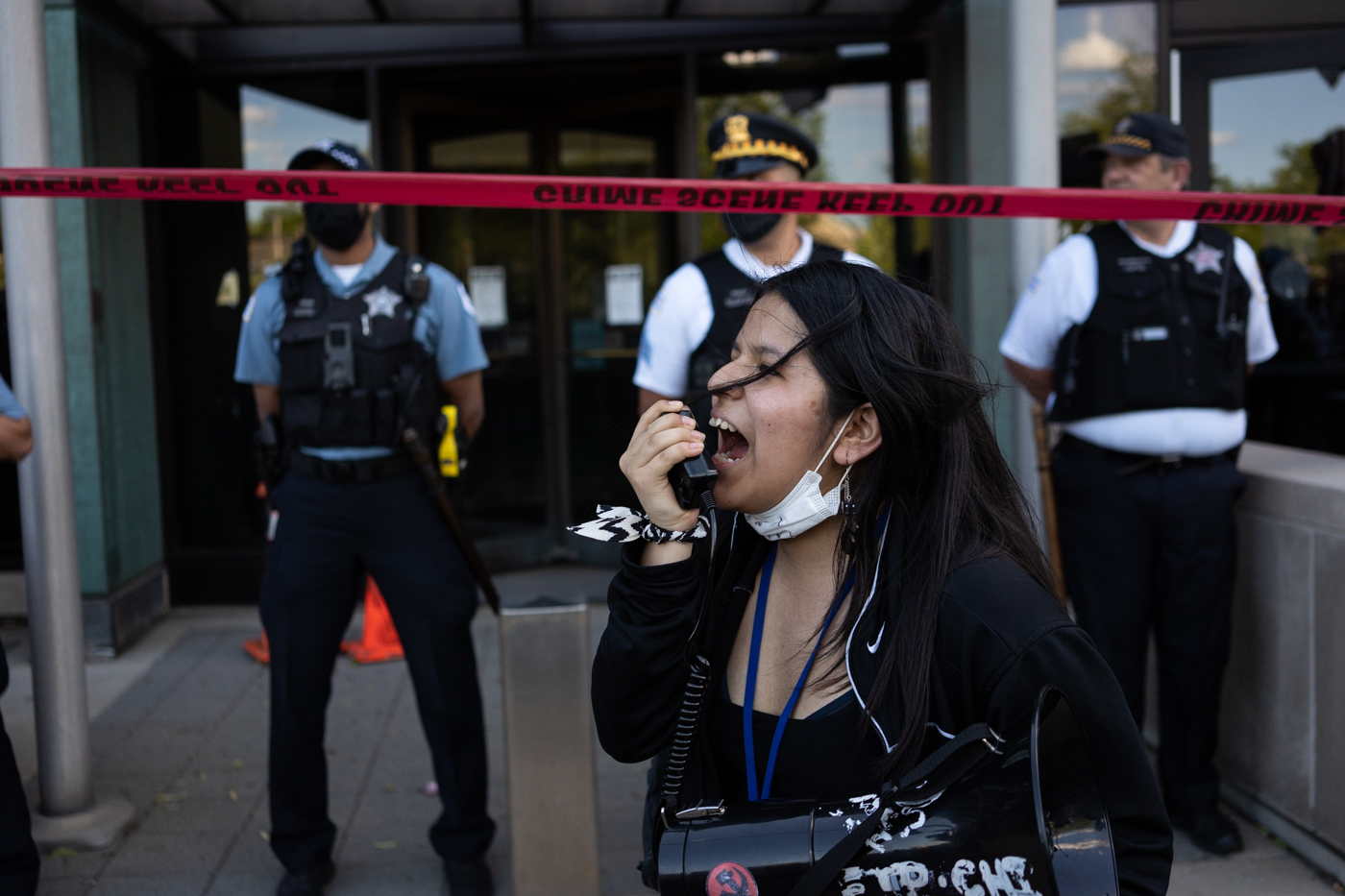The police shooting of 20-year-old Latrell Allen on Sunday afternoon in Englewood has exposed a couple of gaps in Chicago Police Department policy.
One — the exception for members of special squads to the requirement that officers wear body cameras — is being closed, according to CPD. The other — the lack of a policy on foot pursuits — is under review under the federal consent decree mandating reform of the department.
The gaps highlight the slow pace of reform under the consent decree — far too slow for many in the communities affected by police abuse.
The lack of body cameras on the officers who chased and shot Allen has been cited as a factor that allowed misinformation to spread following the shooting, including a false claim that police had killed an unarmed 15-year-old.
It will also be a factor in determining what actually happened — particularly with one eyewitness reporting that Allen was unarmed and had his hands up when he was shot. Police say they fired after Allen shot at them, and they say a gun was recovered in the area where Allen was shot.
Without body cameras, that comes down to the word of the officers, and whether community members trust them. There’s a problem there, since in the past officers are believed to have planted weapons to cover up shootings of unarmed individuals.
When former Mayor Rahm Emanuel rolled out his body camera policy in the wake of the shooting of Laquan McDonald, special squads including gang and narcotics teams were exempted from the requirement. That was a big exception, especially given the history of corruption and abuse among such squads, including a burglary ring and a protection racket.
That practice appears to be changing, though it’s not clear the change is reflected in the district’s policy, which requires body cameras on officers carrying out field duties in Bureau of Patrol districts.
“The Chicago Police Department deeply understands how technology can support accountability and transparency,” according to a statement from CPD. “The department has been actively working to equip all gang investigative, saturation and narcotics teams with body-worn cameras and now, as these units have transitioned into the new citywide Community Safety Team and Critical Incident Response Team. We have prioritized all officers who are a part of these teams to receive body-worn cameras under the 2021 budget if they don’t already have one.”
| RELATED:
|
This comes more than three years after the U.S. Justice Department recommended that CPD equip “officers who regularly engage with the public, including tactical officers, with body cameras” — and just a few months after the independent monitor for the federal consent decree mandating CPD reform noted during a site visit that saturation teams had no bodycams.
Bodycams are not the preventive measure they were once thought to be, as shown by George Floyd’s death, captured on the body camera video of Minneapolis officers who were present. But the absence of such video probably means some people will never believe the police department’s version of last Sunday’s shooting.
As for the lack of a foot pursuit policy, it’s impossible to know how that could have impacted the unfolding of the incident. We do know, however, that reform advocates have highlighted the lack of such a policy and were disappointed when the consent decree didn’t explicitly mandate one, as similar decrees have done in other cities.
The Justice Department’s 2017 report recommended CPD implement a foot pursuit policy. The report “found repeated incidents of unreasonable uses of force stemming from foot pursuits that were initiated with an insufficient basis.” It noted cases where CPD officers initiated foot pursuits “without a basis for believing the person had committed a serious crime” when “the act of fleeing alone was sufficient to trigger a pursuit ending in gunfire, sometimes fatal.”
Instead of taking up the Justice Department’s recommendation, the consent decree requires that CPD update its training bulletin on foot pursuits, collect data on use of the tactic, and conduct a review into whether a policy is needed. Compared to a training bulletin, a departmental policy is a standard to which officers can be held.
The independent monitor for the consent decree reviewed a draft training bulletin last year and found that it didn’t include best practices from other jurisdictions, particularly basic tactical safeguards. The monitor added that “the tone of the training bulletin must do more to impress upon officers the inherent danger of foot pursuits.”
The second monitor’s report, issued in June, said an updated bulletin had incorporated these recommendations. But community groups that are party to the consent decree complained that, despite claims that they’d had meaningful input in reviewing the training bulletin, their recommendations were being rejected — including their demand for clear limits on when foot pursuits can be initiated or continued.
Foot pursuits are “inherently dangerous,” according to the Justice Department report, in part because “officers may experience fatigue or an adrenaline rush that compromises their ability to control a suspect they capture, to fire their weapons accurately, and even to make sound judgments.”
In departments with foot pursuit policies, Sunday’s chase in Englewood would arguably have been discouraged. The policy in New Orleans, implemented under a federal consent decree, for example, allows foot pursuits of individuals suspected of criminal activity but requires that priority be given to public and officer safety over apprehending a suspect. It requires that less risky alternative tactics such as surveillance and containment be used whenever circumstances permit.
The first phase of the consent decree mainly involves getting policies and data collection in place. That’s just the first step on a long road, and many people are already growing impatient.
Let the Justice Department have the last word: CPD “does not have a foot pursuit policy. It should.”



